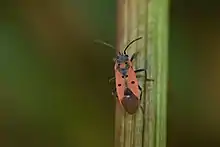Lygaeus creticus
Lygaeus creticus is a species of seed bug in the family Lygaeidae.[1] It is found in areas around the Mediterranean Sea.[2]
| Lygaeus creticus | |
|---|---|
 | |
| Scientific classification | |
| Domain: | Eukaryota |
| Kingdom: | Animalia |
| Phylum: | Arthropoda |
| Class: | Insecta |
| Order: | Hemiptera |
| Suborder: | Heteroptera |
| Family: | Lygaeidae |
| Subfamily: | Lygaeinae |
| Genus: | Lygaeus |
| Species: | L. creticus |
| Binomial name | |
| Lygaeus creticus Lucas, 1853 | |
Taxonomy
Lygaeus creticus was first formally named in 1853 by French entomologist Hippolyte Lucas in Essai sur les animaux articulés qui habitent l'île de Crète.[3]
Description
Both nymphs (image) and adults (image) of Lygaeus creticus are aposematically colored.[4]
Reproduction
Egg mean clutch size has been noted as 20.7 ± 1.76 for once‐mated females.[5] Males have been observed to harass female Lygaeus equestris.[6]
Diet
Lygaeus creticus is phytophagous[7] on Nerium oleander and Sorbus cretica.[3]
References
- "Lygaeus creticus". iNaturalist.
- van der Heyden T (2017). "First records of Lygaeus creticus Lucas, 1854 (Hemiptera: Heteroptera: Lygaeidae: Lygaeinae) for Albania and France" (PDF). Arquivos Entomoloxicos. 18: 65–6.
- "Lygaeus creticus Lucas, 1853". GBIF—the Global Biodiversity Information Facility.
- Burdfield-Steel ER (2012). The causes and consequences of reproductive interference in the Lygaeidae (Doctoral dissertation) (PDF) (Ph.D. thesis). University of St Andrews.
- Burdfield-Steel ER, Shuker DM (June 2014). "The evolutionary ecology of the Lygaeidae". Ecology and Evolution. 4 (11): 2278–301. doi:10.1002/ece3.1093. PMC 4201440. PMID 25360267.
- Shuker DM, Currie N, Hoole T, Burdfield-Steel ER (April 1, 2015). "The extent and costs of reproductive interference among four species of true bug". Population Ecology. 57 (2): 321–331. doi:10.1007/s10144-014-0470-1.
- Cianferoni F, Ceccolini F, Dioli P (January 24, 2018). "New records for Lygaeus creticus Lucas, 1854 in Italy and Corsica (Hemiptera: Heteroptera: Lygaeidae)". Natural History Sciences (in Italian). 5 (1). doi:10.4081/nhs.2018.346 – via sisn.pagepress.org.
This article is issued from Wikipedia. The text is licensed under Creative Commons - Attribution - Sharealike. Additional terms may apply for the media files.